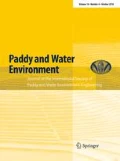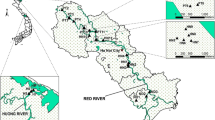Abstract
The soil sample of a paddy field was found to be contaminated by copper (Cu). The application of wastewater as the nitrogen fertilizer was identified as the cause in this study. The concentration of Cu in soil and rice plants was therefore explored. The paddy soil characteristics indicated a strong anaerobic environment. The Cu concentration in topsoil was 123 ± 24 mg kg−1. The Community Bureau of Reference (BCR)’s fractionation of Cu from high to low was residual fraction (62.1%) > organically bounded and sulfide-bounded fractions (24.2%) > iron oxide and manganese oxide fraction (8.8%) > acid-soluble fractions (4.8%). The concentration of Cu in rice organs was the highest in the roots, followed by the straw, grain, and husk. The correlation of Cu in rice straws with every fractionation of Cu in soil was strong. However, the weak correlation between Cu in rice grains and soil was found. The result of Cu mass balance in the soil–rice cultivation system showed that less than 0.1% of Cu was translocated to rice plant. The average Cu intake through rice grain consumption (621 μg day−1) indicated the Cu supply to human body basic need without any potential negative health impacts to consumer. However, this level of Cu may cause toxicity to rice growth and productivity. Soil replacement may be more appropriate than soil treatment in this study. In addition, agricultural practices should be managed to prevent further contamination and promote more aerobic conditions.



Similar content being viewed by others
References
Abedin MJ, Howells C, Meharg AA (2002) Arsenic uptake and accumulation in rice (Oryza sativa L.) irrigated with contaminated water. Plant Soil 240:311–319
Alloway BJ (1995) The origins of heavy metals in soils. Chapman & Hall, London
Assawadithalerd M, Siangliw M, Tongcumpou C (2014) Effects of organic fertilizer on Cd bioavailability and Cd accumulation in rice grown in contaminated paddy soil. Appl Environ Res 39(2):67–76
Bureau of Rice Research and Development, Rice Department, Ministry of Agriculture and Cooperatives (Thailand) (2009) Fertilization based on soil analysis in rice cultivation. ISBN:978-974-403-624-7
Bureau of Rice Research and Development, Rice Department, Ministry of Agriculture and Cooperatives (Thailand) (2016) Rice knowledge Bank. http://www.ricethailand.go.th/rkb3/title-rice_yield_per_rai.htm
Cao ZH, Hu ZY (2000) Copper contamination in paddy soils irrigated with wastewater. Chemosphere 41:3–6
Chinoim N, Sinbuathong N (2010) Heavy metal contamination of soils from organic paddy fields in Thailand. In: 19th World Congress of Soil Science, Soil Solutions for a Changing World, pp 119–121
Cooper DC, Morse JW (1998) Extractability of metal sulfide minerals in acidic solutions: application to environmental studies of trace metal contamination within anoxic sediments. Environ Sci Technol 32:1076–1078
Damrongsiri S (2018) Transformation of heavy metal fractionation under changing environments: a case study of a drainage system in an e-waste dismantling community. Environ Sci Pollut Res 25:11800–11811
Fageria NK, Santos AB, Cutrim VA (2008) Dry matter and yield of lowland rice genotypes as influence by nitrogen fertilization. J Plant Nutr 31:788–795
FAO/WHO (1972) Evaluation of certain food additives and of the contaminants mercury, lead and cadmium. FAO Nutrition Meetings Report Series 51, WHO Technical Report Series 505, Rome
Fernández-Calviño D, Pérez-Novo C, Nóvoa-Muñoz JC, Arias-Estévez M (2009) Copper fractionation and release from soils devoted to different crops. J Hazard Mater 167:797–802
Fu QL, Weng N, Fujii M, Zhou DM (2018) Temporal variability in Cu speciation, phytotoxicity, and soil microbial activity of Cu-polluted soils as affected by elevated temperature. Chemosphere 194:285–296
Hartley W, Dickinson NM (2010) Exposure of an anoxic and contaminated canal sediment: mobility of metal(loid)s. Environ Pollut 158:649–657
Hensawang S, Chanpiwat P (2017) Health impact assessment of arsenic and cadmium intake via rice consumption in Bangkok, Thailand. Environ Monit Assess 189:599. https://doi.org/10.1007/s10661-017-6321-8
Hinkle DE, Wiersma W, Jurs SG (2003) Applied statistics for the behavioral sciences, 5th edn. Houghton Mifflin, Boston
Hoque MM, Kobata T (2000) Effect of soil compaction on the grain yield of rice (Oryza sativa L.) under water-deficit stress during the reproductive stage. Plant Prod Sci 3(3):316–322
Huang JH, Hsu SH, Wang SL (2011) Effects of rice straw ash amendment on Cu solubility and distribution in flooded rice paddy soils. J Hazard Mater 186:1801–1807
Institute of Medicine (2001) Dietary reference intakes for vitamin A, vitamin K, arsenic, boron, chromium, copper, iodine, iron, manganese, molybdenum, nickel, silicon, vanadium, and zinc. The National Academies Press, Washington DC
Intorpetch B, Wisawapipat W, Arunlertaree C, Teartisup P (2014) Soil physicochemical status and nutrient management for paddy soils in the lower central plain of Thailand after the flood disaster in 2011. Environ Nat Resour J 12(1):57–67
Kögel-Knabner I, Amelung W, Cao Z, Fiedler S, Frenzel P, Jahn R, Kalbitz K, Kölbl A, Schloter M (2010) Biogeochemistry of paddy soils. Geoderma 157:1–14
Lee KJ, Feng YY, Choi DH, Lee BW (2016) Lead accumulation and distribution in different rice cultivars. J Crop Sci Biotechnol 19:323–328
Liu X, Wang H, Zhou J, Hu F, Zhu D, Chen Z, Liu Y (2016) Effect of N fertilization pattern on rice yield, N use efficiency and fertilizer-N fate in the Yangtze River Basin, China. PLOS One 11(11):e0166002. https://doi.org/10.1371/journal.pone.0166002
Luh BS (1991) Rice hulls. In: Luh BS (ed) Rice. Springer, Boston
Luo Y, Jiang X, Wu L, Song J, Wu S, Lu R, Christie P (2003) Accumulation and chemical fractionation of Cu in a paddy soil irrigated with Cu-rich wastewater. Geoderma 115:113–120
Mitsch WJ, Gosselink JG (2000) Wetlands, 3rd edn. Wiley, New York
Prakongkep N, Suddhiprakarn A, Kheoruenromne I, Smirk M, Gilkes RJ (2008) The geochemistry of Thai paddy soils. Geoderma 144:310–324
Qi Y, Huang B, Darilek JL (2014) Effect of drying on heavy metal fraction distribution in rice paddy soil. PLOS One 9(5):e97327. https://doi.org/10.1371/journal.pone.0097327
Quintaes KD, Diez-Garcia RW (2015) The importance of minerals in the human diet. In: de la Guardia M (ed) Handbook of mineral elements in food. Wiley, Chichester
Race M, Marotta R, Fabbricino M, Pirozzi F, Andreozzi R, Cortese L, Giudicianni P (2016) Copper and zinc removal from contaminated soils through soil washing process using ethylenediaminedisuccinic acid as a chelating agent: a modeling investigation. J Environ Chem Eng 4:2878–2891
Tanji KK, Gao S, Scardaci SC, Chow AT (2003) Characterizing redox status of paddy soils with incorporated rice straw. Geoderma 114:333–353
Tian Z, Li J, He X, Jia X, Yang F, Wang Z (2017) Grain yield, dry weight and phosphorus accumulation and translocation in two rice (Oryza sativa L.) varieties as affected by salt-alkali and phosphorus. Sustainability 9:1461
Ure AM, Quevauviller Ph, Muntau H, Griepink B (1993) Speciation of heavy metals in soils and sediments. An account of the improvement and harmonization of extraction techniques undertaken under the auspices of the BCR of the commission of the european communities. Int J Environ Anal Chem 51:135–151
USDA (1996) Method code 6A1. Soil survey laboratory methods manual
van Griethuysen C, Gillissen F, Koelmans AA (2002) Measuring acid volatile sulphide in floodplain lake sediments: effect of reaction time, sample size and aeration. Chemosphere 47:395–400
Xiao L, Guan D, Peart MR, Chen Y, Li Q, Da J (2017a) The influence of bioavailable heavy metals and microbial parameters of soil on the metal accumulation in rice grain. Chemosphere 185:868–878
Xiao L, Guan D, Peart MR, Chen Y, Li Q (2017b) The respective effects of soil heavy metal fractions by sequential extraction procedure and soil properties on the accumulation of heavy metals in rice grains and brassicas. Environ Sci Pollut Res 24:2558–2571
Xu J, Yang L, Wang Z, Dong G, Huang J, Wang Y (2006) Toxicity of copper on rice growth and accumulation of copper in rice grain in copper contaminated soil. Chemosphere 62:602–607
Yan YP, He JY, Zhu C, Cheng C, Pan XB, Sun ZY (2006) Accumulation of copper in brown rice and effect of copper on rice growth and grain yield in different rice cultivars. Chemosphere 65:1690–1696
Yu TR (1991) Characteristics of soil acidity of paddy soils in relation to rice growth. In: Wright RJ, Baligar VC, Murrmann RP (eds) Plant-soil interactions at low pH, vol 45. Development in Plant and Soil Sciences. Springer, Dordrecht, pp 107–112. https://doi.org/10.1007/978-94-011-3438-5_12
Yu HY, Li FB, Liu CS, Huang W, Liu TX, Yu WM (2016) Iron redox cycling coupled to transformation and immobilization of heavy metals: implications for paddy rice safety in the red soil of south China. Adv Agron 137:279–317
Zhang J, Li H, Zhou Y, Dou L, Cai L, Mo L, You J (2018) Bioavailability and soil-to-crop transfer of heavy metals in farmland soils: a case study in the Pearl River Delta, South China. Environ Pollut 235:710–719
Zhao K, Liu X, Zhang W (2011) Spatial dependence and bioavailability of metal fractions in paddy fields on metal concentrations in rice grain at a regional scale. J Soils Sediments 11:1165–1177
Zhou W, Hesterberg D, Hansen PD, Hutchison KJ, Sayers DE (1999) Stability of copper sulfide in a contaminated soil. J Synchrotron Radiat 6:630–632
Funding
This work was supported by the S&T Postgraduate Education and Research Development Office, PERDO [Grant Number: HSM-PJ-CT-18-15].
Author information
Authors and Affiliations
Corresponding author
Rights and permissions
About this article
Cite this article
Damrongsiri, S., Chotipong, A. A preliminary investigation for Cu distribution in paddy soil and rice plants in contaminated paddy fields. Paddy Water Environ 18, 283–290 (2020). https://doi.org/10.1007/s10333-019-00781-8
Received:
Revised:
Accepted:
Published:
Issue Date:
DOI: https://doi.org/10.1007/s10333-019-00781-8




